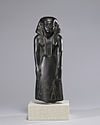| Padiiset's Statue | |
|---|---|
 Padiiset's Statue in the Walters Art Museum, showing the front and back views Padiiset's Statue in the Walters Art Museum, showing the front and back views | |
 | |
| Material | Basalt |
| Writing | Egyptian hieroglyphs |
| Created | 1780–1700 BC (Inscription: 900–850 BC) |
| Discovered | 1894 |
| Present location | Walters Art Museum |
| Identification | 22203 |
Padiiset's Statue or Pateese's Statue, also described as the Statue of a vizier usurped by Padiiset, is a basalt statue found in 1894 in an unknown location in the Egyptian delta which includes an inscription referring to trade between Canaan and the Peleset (Philistines) and Ancient Egypt during the Third Intermediate Period. It was purchased by Henry Walters in 1928, and is now in the Walters Art Museum.
It is the second – and last – known Egyptian reference to Canaan, coming more than 300 years after the preceding known inscription.
The statue is made of black basalt and measures 30.5 x 10.25 x 11.5 cm, and was created in the Middle Kingdom period to commemorate a government vizier. Scholars believe that a millennium later the original inscription was erased and replaced with inscriptions on the front and back representing "Pa-di-iset, son of Apy" and worshipping the gods Osiris, Horus, and Isis.
The inscriptions read:
Ka of Osiris: Pa-di-iset, the justified, son of Apy.
The only renowned one, the impartial envoy of Philistine Canaan, Pa-di-iset, son of Apy.
References
- Lemche, p.54
- Chassinat, 1901, p.98: "Au commencement de 1894, on découvrit, dans une localité du Delta dont je n’ai pu savoir le nom, une statuette en basalte noir légèrement mutilée."
- ^ The Statuette of an Egyptian Commissioner in Syria, Georg Steindorff, The Journal of Egyptian Archaeology, Vol. 25, No. 1 (Jun., 1939), pp. 30-33: "At the beginning of the year 1894 was found, reputedly in the Delta, a slightly damaged statuette of black basalt..."
- Statue of a vizier usurped by Padiiset, at the Walters Art Museum
- The Philistines in Transition: A History from Ca. 1000-730 B.C.E., Carl S. Ehrlich, p65
- Drews 1998, p. 49a:"In the Papyrus Harris, from the middle of the twelfth century, the late Ramesses III claims to have built for Amon a temple in ‘the Canaan’ of Djahi. More than three centuries later comes the next—and very last—Egyptian reference to ‘Canaan’ or ‘the Canaan’: a basalt statuette, usually assigned to the Twenty-Second Dynasty, is labeled, ‘Envoy of the Canaan and of Palestine, Pa-di-Eset, the son of Apy’."
- Helmut Brandl, Untersuchungen zur steinernen Privatplastik der Dritten Zwischenzeit: Typologie - Ikonographie -Stilistik, mbv-publishers, Berlin 2008, pp. 218-219, pls. 122, 180b, 186a (doc. U-1.1).
Bibliography
- Editio princeps: Émile Gaston Chassinat, "Un interprète égyptien pour les pays cananéens". Bulletin de L'Institut Français d'Archéologie Orientale 1, 1901, 98
- Drews, Robert (1998), "Canaanites and Philistines", Journal for the Study of the Old Testament, 23 (81): 39–61, doi:10.1177/030908929802308104, S2CID 144074940